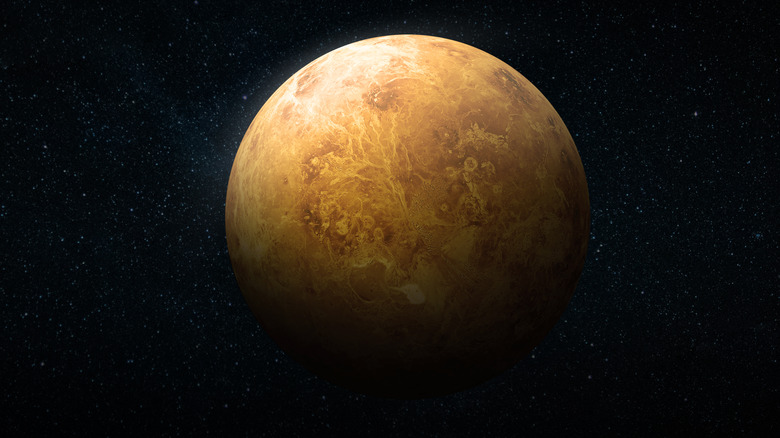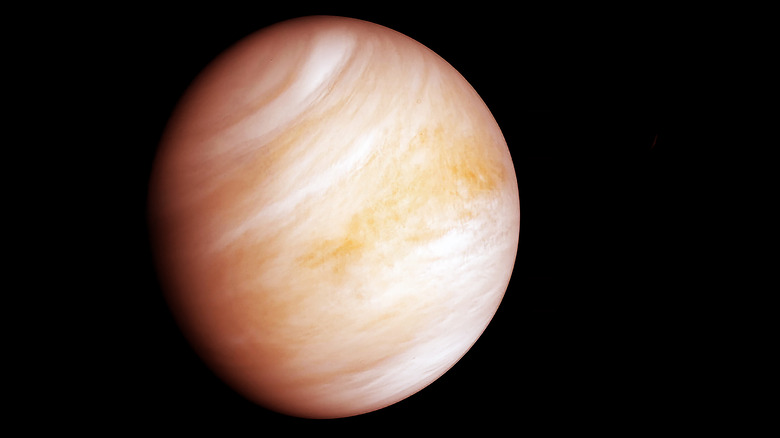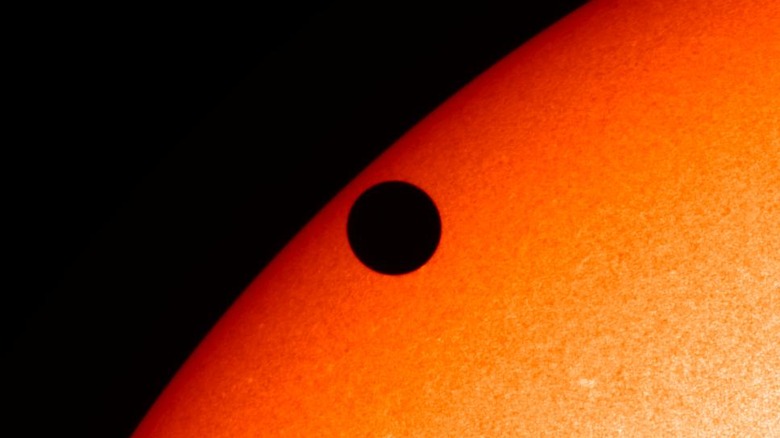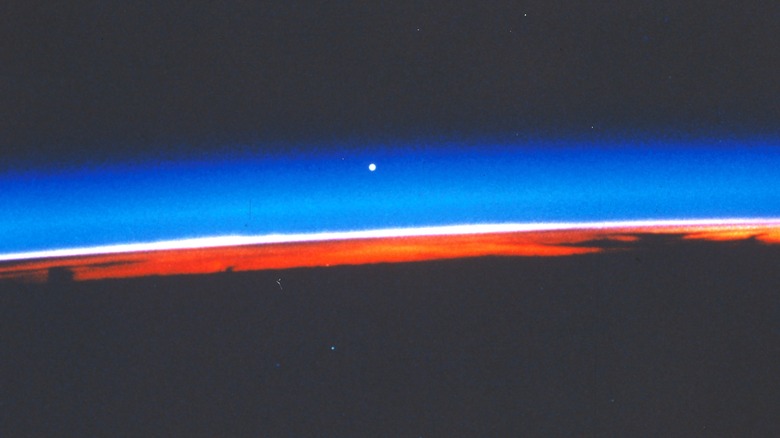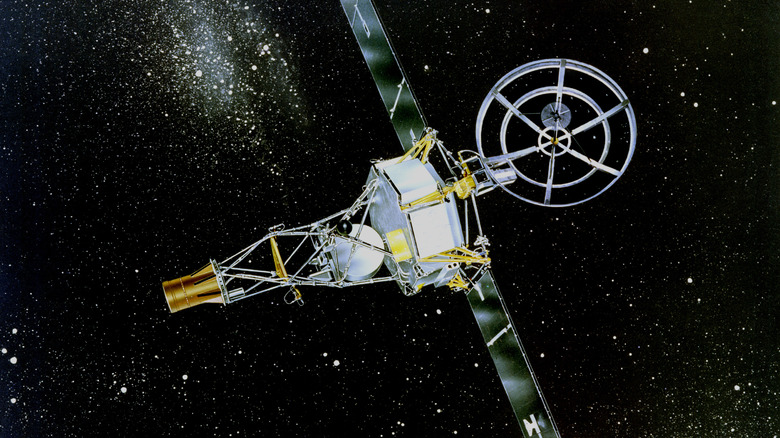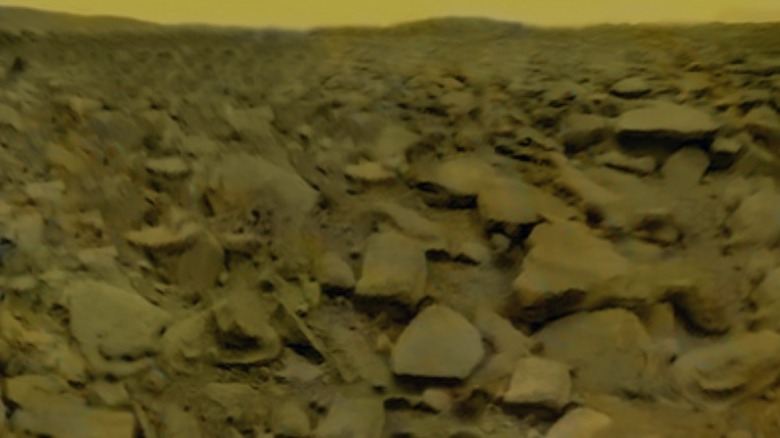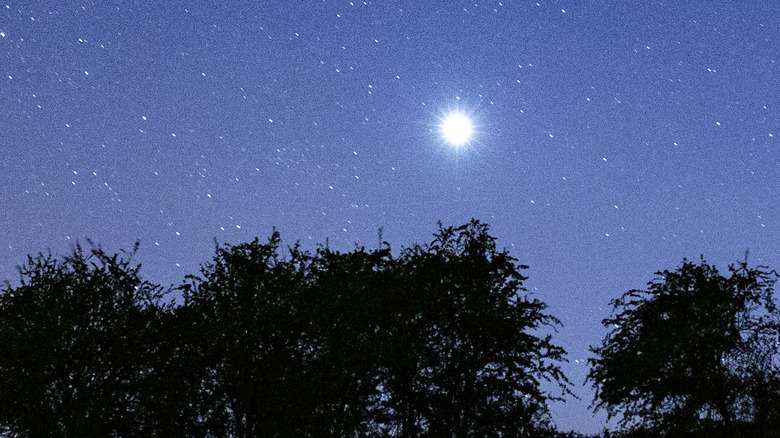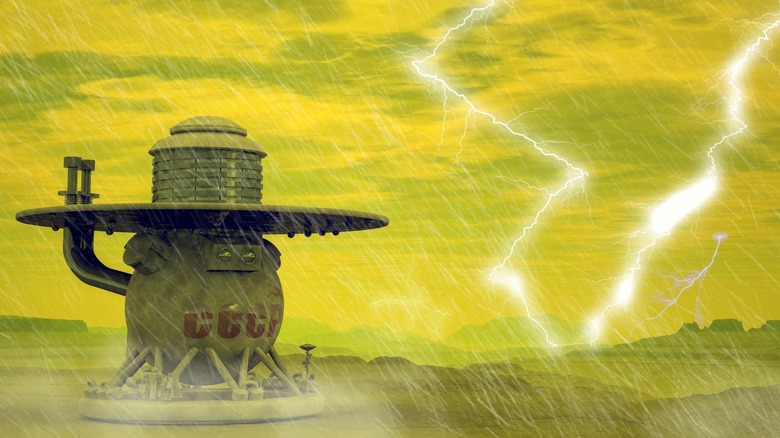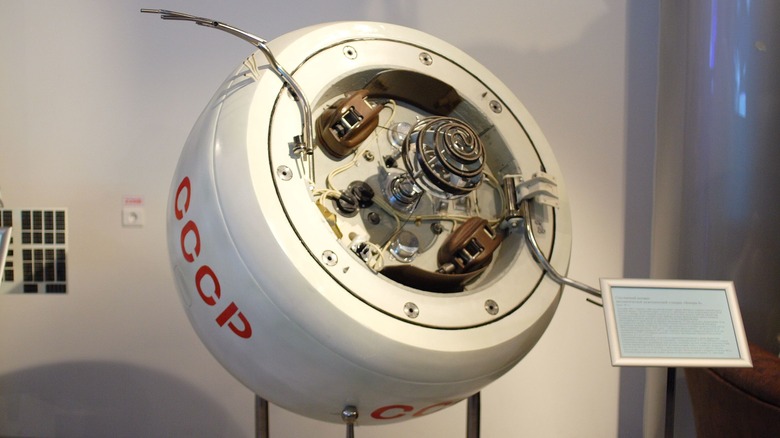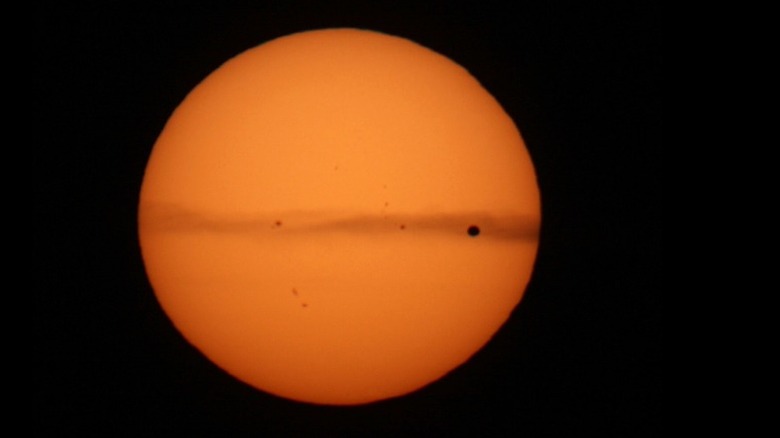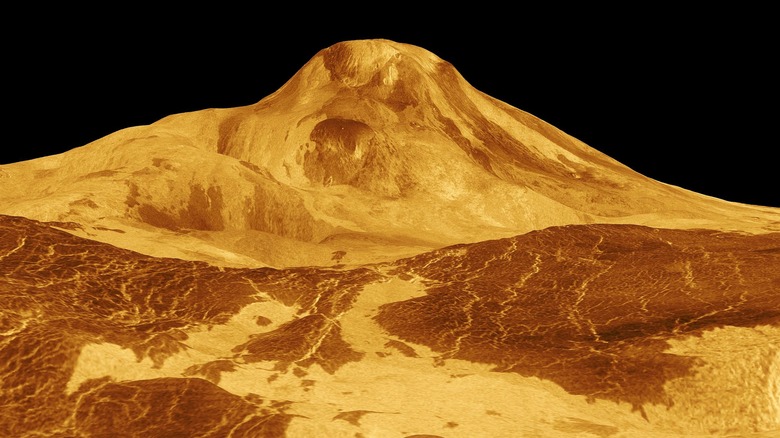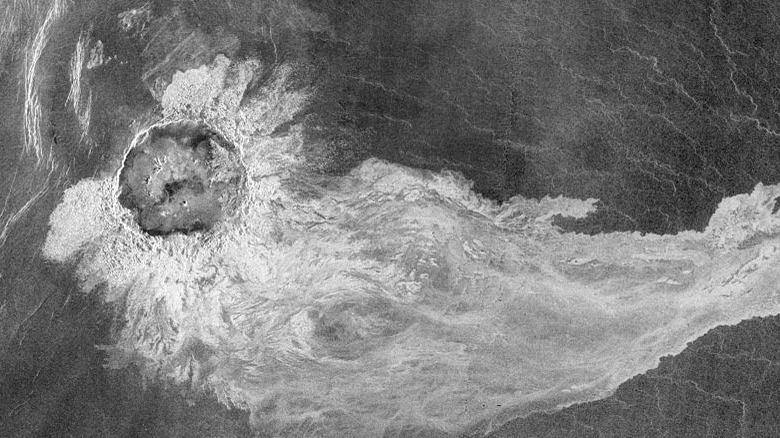Strange Details About The Planet Venus
The planet Venus has fascinated humans since people looked at the heavens. After the sun and moon, Venus is the most brilliant object in the sky, per EarthSky. Studied by ancient astronomers, before telescopes, Venus was one of the five planets known to humans in antiquity and considered divine (via Britannica). Its name comes from the Roman goddess of love, though, according to Space.com, ancient stargazers thought Venus was two stars: a morning star and an evening star, named after the times of the planet's appearances.
The advent of the telescope and other technologies allowed for greater study of the planet. By the 1920s, it was confirmed the planet was covered with thick clouds, and by the 1930s, full of carbon dioxide. The book "Venus" asserts that these early discoveries led scientists to speculate that there must be copious amounts of water on the planet. Was Venus a second earth? Writers took this idea and ran with it. For example, Edgar Rice Burroughs began in the 1930s to write a whole series of adventure novels set on Venus, featuring monsters, heroes, princesses, and cities built atop immense forests.
But alas, as science progressed, we learned that none of these things were remotely possible on Venus. In fact, Venus is one of the most extreme places in the solar system. Let's take a look at some of the stranger-than-fiction details of the planet closest to Earth.
Venus is Earth's evil twin
Venus is one of the terrestrial planets. As Space.com explains, this means it's a planet made mainly of rock with hard surfaces. Aside from Venus, the terrestrial planets include Mercury, Earth, and Mars. Venus is the second closest planet to the sun and Earth's astronomical next-door neighbor — if Earth was Homer Simpson, Venus would be Ned Flanders.
No planet comes nearer. Depending on where Venus is in its orbit relative to Earth, it can be as far away as 162 million miles or as near as 24 million miles. It's because Venus' orbit is closer to the sun than Earth's that the planet makes most of its appearances in the morning or early evening sky.
What also makes Venus intriguing is its size. Per Britannica, Venus is very similar to Earth in its mass, size, and density. With a radius of 3,760.4 miles at the equator, it's about 95% the size of Earth, while its mass is 81.5% as much. Venusian gravity operates at about 90% of Earth's gravity; thus, you'd be a little bit lighter on Venus but not by much. All these similarities and its nearby location has caused some to call Venus "Earth's twin." But a more apt nickname is given by the European Space Agency as "Earth's evil twin."
Venus has a poisonous atmosphere
While from a telescope Venus' cloudy and brilliant atmosphere makes it seem like a jewel in the sky, you need to stay as far away from that astronomical bling as possible. Per NASA, Venus' atmosphere is 96% carbon dioxide, which, understandably, obscures its surface. Its clouds, meanwhile, contain sulfuric acid.
The planet's atmosphere is tremendously thick, which creates an incredible amount of atmospheric pressure, according to Space.com. If you were to stand on Venus' surface, you'd experience 95 times the pressure that one would feel at sea level on Earth. To understand how extreme this is, to feel the same amount of pressure, Space.com says you'd have to dive 3,000 feet under the sea.
This incredibly heavy brew of carbon dioxide with more than a pinch of sulfur produces phenomena worthy of any nightmare. For example, NASA reports that Venus has unusual lightning. Normally, lightning is produced by clouds containing water. But on Venus, its sulfuric acid clouds somehow create its lightning, the only known planet to do so. Further, the lightning, if observed, would appear orange, since as Space Center Houston explains, the planet's thick cloud cover filters out other colors of light.
Venus is the hottest planet in the solar system
Nowadays, there's a global movement to control greenhouse gas emissions. According to the EPA, certain gasses when released into the atmosphere trap heat — like a greenhouse. This has the effect of raising global temperatures and causing environmental havoc. On Earth, carbon dioxide is the world's leading greenhouse gas. Currently, Space.com tells us the amount of carbon dioxide in our atmosphere is less than ½ a percent, and it only takes a little more to create extreme weather.
As noted, on Venus, carbon dioxide accounts for 96% of its atmosphere. Venus is in essence a heat sink. Space.com reports that on the Venusian surface, the average temperature is 872 degrees Fahrenheit — hot enough to melt lead. This is even hotter than Mercury, which is the closest planet to the sun. NASA maintains that this temperature makes Venus the hottest planet in the solar system outside the Sun.
Temperatures on Venus are pretty consistent on the surface, but it does cool off as you leave the planet. In the planet's upper atmosphere you might experience temperatures that range from ‐109.4 F to ‐343.4 F (via Space.com). So if you were to descend to the Venusian surface in a balloon, you'd first experience extreme cold before becoming overwhelmed with heat more hellish than Hades. It's for this reason that landers on the planet only last for hours at most, per Wired.
Venus does not have seasons
On Earth, if you were to travel from one of the poles to the equator or vice versa you would rightly expect to see sharp temperature changes. And in most places on Earth, if you were just to stand still and experience a year, you would expect to see changes in climate throughout the year. These are the seasons.
NASA explains that each planet experiences the seasons in different ways to varying degrees. The main reason for seasons is the tilt of a planet's axis. For example, Earth's tilt is 23.5 degrees, which means that when in orbit, the side tilted more toward the sun absorbs more energy. When this happens, this side of Earth experiences summer. Venus, however, is tilted just 2.6 degrees (per Cosmos). This means that as the planet goes around the sun, both sides of Venus are exposed the same all the time; meaning, there are no seasons.
Another factor which prevents seasons on Venus is the greenhouse gas atmosphere. Universe Today notes that the thick layers of carbon dioxide on Venus trap heat in such a way that it's hellishly hot on Venus's surface without any appreciable difference between its poles and the equator.
Venus spins backwards
One of the strangest characteristics of Venus is its rotation. Virtually almost all planets, including Earth, rotate counterclockwise if you look down on the planet from its northern pole. Per Britannica, this is prograde, or direct, rotation. The New York Times explains that most planets rotate in this way due to events at the birth of the solar system.
Venus, however, rotates in a clockwise rotation, called retrograde. Only the gas giant Uranus also rotates in this direction. This means that if you were on Venus and could see the sun past the thick atmosphere, the sun would rise in the west and set in the east.
It's not truly understood why Venus spins in reverse, but the Times provides three possibilities. One long-standing hypothesis is that Venus at some point in its history was struck by an object that may have been as large as a planet. The resulting cataclysm caused the planet to start spinning in the opposite direction.
A second theory is that geological action in the planet's core caused friction, which resulted in the planet spinning retrograde. One last theory is that the planet started spinning prograde, but due to various complexities slowed over time before settling into its retrograde spin.
A day on Venus is longer than its year
Venus may spin the wrong way, but it does so very slowly. Per NASA Space Place, a single Venusian day is 243 Earth days. Because the spin is so slow, this means that the usual centrifugal forces that make most planets a bit squashed-looking as oblate spheroids really don't come into play on Venus. It's a near perfect sphere.
What is even stranger is that a year on Venus, that is the completion of one orbit around the sun, is 224.7 Earth days. In fact, a year and a day on Venus are nearly the same thing. It's dizzying to think how if there ever had been an alien civilization on Venus, how they could create a calendar.
Reasons are offered as to the reasons for this slow spin. The University of California at Riverside suggests that Venus is partially tidally locked to the sun. This is a phenomenon that occurs when a massive object holds a smaller object in its gravitational thrall. The result is that the same side of the object always faces the other.
For example, the moon and Earth are tidally locked, which is why we never see the dark side of the moon. Research published in Nature suggests tidal locking also may be a partial explanation for why Venus' climate is so extreme since the slow rotation seems to encourage less moderate climates.
Venus is one of the brightest objects in the sky
Venus is the third-brightest object in the sky. As EarthSky explains, some people may think Venus' brightness is due to the planet's proximity to Earth. However, this is not the case. Reflectivity is measured by albedo, which is a measure of how much light is reflected off the object. This can be expressed as a percentage. For example, the albedo of the moon is .12, per Universe Today. This means that 12% of the light that strikes the moon is reflected back.
If an object has a 1.0 albedo, that means that all the light that strikes it is bouncing back. The only object in the solar system that gets that high is Saturn's moon Enceladus, which Universe Today tells us has an albedo of 99% due to what NASA reports is its icy composition. If the Earth had Enceladus as a moon, it may very much be like having a second sun without the heat.
While Venus is not Enceladus, it does have a very high albedo, which according to EarthSky, approaches .7, meaning that 70% of all light is reflected back into space. This is due to the planet's yellowish-white atmosphere. To put this into comparison, if you were on Venus and could see through the clouds to Earth, you would find our planet to be comparatively dimmer with an albedo of .367.
Venus was the first planet to be explored by humans
With Venus being so close to Earth, it was one of the first targets of space exploration. The first flyby of the planet was in 1962 with NASA's Mariner 2 mission. Subsequent Mariner missions also approached the planet. NASA's 1978 Pioneer Venus mission sent an orbiter to the planet, which released probes into the atmosphere, giving us more detailed information about the planet.
Perhaps more significant was the Soviet Union's efforts to understand our closest neighbor. In 1967, its Venera 4 mission did a flyby, which also launched a probe into the atmosphere. More spectacular was 1970's Venera 7, which landed on the planet. This was followed by the Veneras 9 and 10, which not only landed on Venus, but provided us the first images taken from the surface. Even more comprehensive understanding of Venus was obtained in the Soviet's 1983 Veneras 15 and 16, which orbited the planet and used radar to pierce the thick atmosphere to map the surface. In all cases, each mission to Venus showed that there was no chance of life there (via Space.com).
Venus continued to be an object of study into the 21st century, with efforts by the European Space Agency (ESA) as well as Japan (JAXA). NASA has even studied sending a crewed mission to the planet, but instead of landing on the deadly surface, would use airships to cruise through a layer of the atmosphere, which is cooler.
Venus's atmosphere superrotates
One mystery of Venus that may be solved is the speed of its atmosphere. According to Space.com, the planet's upper atmosphere moves incredibly fast. So fast in fact, that it moves around the planet in a 96-hour period. This is 60 times the speed of the planet's rotation. Scientists estimate the speed of the fastest portions of the atmosphere to move at 245 miles per hour.
This is a phenomenon called super‐rotation and is also seen on Saturn's moon Titan. In comparison, National Geographic explains that the average atmospheric jet stream on Earth usually moves between 80 and 145 miles per hour, though it can occasionally reach Venusian speeds. However, if you were on Venus' surface, the wind speed would be considerably lower.
The cause of Venus' super‐rotation seems to be thermal tides. Space.com describes these as disparities in air pressure, which are caused by heat from the sun at the planet's equator. This, according to research in Science, creates enough angular momentum to overcome the friction caused by the slowly spinning planet.
It's also because of this phenomenon that heat on Venus is relatively equally spread throughout. While one might expect that a planet with one constantly facing the sun would be incredibly hot on that side and incredibly frigid on the other, thanks to super‐rotation, everything on Venus is equally and hellishly hot and oppressive.
Venus has an electrical field but not a magnetic field
One feature of Earth that makes it a suitable place for life is its magnetic field. Space.com explains how our planet generates a magnetic force that envelopes the planet and reaches into space in the magnetosphere. This deflects charged particles from the sun known as the solar wind. Without the magnetosphere, life would be impossible.
In order for any planet to generate a magnetic field, it needs a liquid core that can conduct electricity and spin fast enough to generate it. Sadly, Venus' very slow rotation prevents it from developing a significant one. Instead, the ESA found that the planet has an electric field — a first for any planet.
The electric field seems to be caused by the lack of a magnetosphere. As the ESA explains, as the solar wind envelopes Venus, it draws negative electrons upward. But these are still connected to heavier positive protons and ions, which are drawn down by gravity. The result is a vertical electrical field with a potential of 10 volts, which is much stronger than the two-volt electrical field scientists expected to find.
This field, in fact, may have had a major impact on Venus' development. According to NASA, Venus may have had oceans with water that had boiled away. One may expect to find water vapor in the atmosphere. However, there is none. The electric field would have stripped water molecules out of the atmosphere, leaving only the carbon dioxide in its place.
Venus has a landscape from Hades
Venus may be the goddess of love, but if you were to journey to the surface of the planet, you may think to rename it Tartarus. The surface, according to NASA, is relatively young geologically speaking — it seems to have been remade somewhere between 350 to 750 million years ago. The average age of a piece of Venusian real estate is younger, perhaps 150 million years old. This was probably due to volcanic action.
If you were to take a road trip on Venus, you'd see a varied terrain, mainly consisting of valleys and mountains. Some of the uplands have been named after women, such as Ishtar Terra on the planet's northern pole and Aphrodite Terra on the equator. The planet even has a 36,000-foot-tall mountain — higher than any on Earth. It also has strange landscapes, which may be caused more by the broiling heat of the planet and its interaction with the surface.
Per the University of Arizona, Venus today has no evidence of continental plates, though it does have its volcanoes. It's speculated that Venus may have gone through several resurfacing episodes. Since there is no gradual continental drift, as there is on Earth, Venus may experience explosive episodes where heat wells up in the planet and then explodes. Sort of like a giant pimple but with hot lava.
Venus has no small craters
Venus' young surface means that there are few impact craters. That means that meteor bombardments are covered up by geologic activity. The case is the same on Earth. What's more, on Venus, there are a few extra large craters that can be hundreds of miles wide, but it's more common to find craters tens of miles wide, per Britannica. However, there's no crater on Venus under 1.2 miles wide. This is because smaller meteors just get burned up in the planet's thick atmosphere.
Impact craters on Venus also have strange characteristics. According to the National Air and Space Museum, meteors that reach Venus may be broken up by the planet's atmosphere into clusters and pepper the ground like a shotgun. Other meteors cause large lava flows, which are probably abetted by Venus' high surface temperatures. In addition, the heavy atmosphere of Venus prevents meteors from sending up large amounts of material after impact, resulting in smaller craters that don't extend outward as much.

